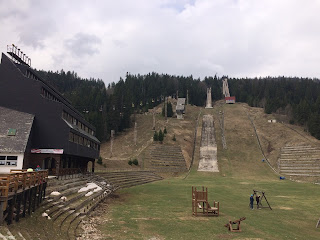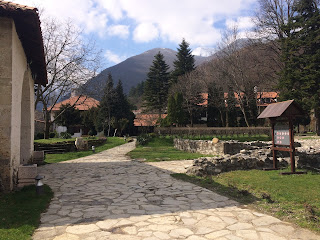When my friend visited, we took a day-trip from Sarajevo to Belgrade -- an excellent way to get between cities: stop and see the highlights that lie in between! Our first stop was Višegrad known for the bridge popularized in Ivo Andrić's "Bridge on the Drina," which won the Nobel Prize for Literature in 1961. As the title indicates, this bridge passes over the Drina river, which forms a large portion of the border between Bosnia and Serbia.
After crossing the border, we headed to Drvengrad, literally "wooden city," the only stop I'd visited during Bridge Year. Serbian filmmaker Emir Kustarica created this ethno-village for a film set, but instead of breaking it down when they wrapped the film, he's preserved it entirely. It now sustains itself with tourism and an annual film festival. This city hasn't changed a bit, which makes sense since it's artificial to begin with.
Then came the stop I was most looking forward to. Šarganska osmica is a piece of a railroad that once ran from Sarajevo to Belgrade. Mountains define much of the topography of Eastern Bosnia and Western Serbia, which forced this train to curl around and bisect various mountains in order to reach its destination. The particular strip that remains looks like the number 8 from above, though it begins and ends at different magnitudes. My friend and I were thrilled by this roughly 40-minute ride on a crickety train. If not for this day-trip, however, I would not have made it. Like much of the untouched beauty in the Balkans, the only way to reach it is by car. The train between the two cities no longer runs, and there are actually worse trains now than there were at the turn of the 20th century according to some Bosnians; there once was a train from Vienna to Sarajevo! During its brief history in the Austro-Hungarian Empire, Sarajevo became a modern city with electricity, modern buildings, and an extensive railway system. Some Sarajevans wish their city had benefitted more from this alliance cut short by Gavrilo Princip, who remains a controversial figure.
Next we headed to Tara National Park, which overlooks the Drina. At this point, a thick fog hung over the mountain. We were supposed to go on a short hike to a viewpoint, but our guide suggested we skip it since we could barely see ten feet in front of us let alone the Drina several hundred meters below. But since the fog entranced my friend and me, hike we did through a clouded forest.
Finally we stopped briefly to see this house precariously positioned on a rock in the middle of the Drina.
As much as I love riding trains to get from place to place and watching the countryside go by, this day reaffirmed how much lies between these hubs that most people either don't know about or don't have easy access to. I hope more of these city-to-city day-trips pop up.
View from the bridge.
View of the bridge.
View of the bridge from the water!
After crossing the border, we headed to Drvengrad, literally "wooden city," the only stop I'd visited during Bridge Year. Serbian filmmaker Emir Kustarica created this ethno-village for a film set, but instead of breaking it down when they wrapped the film, he's preserved it entirely. It now sustains itself with tourism and an annual film festival. This city hasn't changed a bit, which makes sense since it's artificial to begin with.
Then came the stop I was most looking forward to. Šarganska osmica is a piece of a railroad that once ran from Sarajevo to Belgrade. Mountains define much of the topography of Eastern Bosnia and Western Serbia, which forced this train to curl around and bisect various mountains in order to reach its destination. The particular strip that remains looks like the number 8 from above, though it begins and ends at different magnitudes. My friend and I were thrilled by this roughly 40-minute ride on a crickety train. If not for this day-trip, however, I would not have made it. Like much of the untouched beauty in the Balkans, the only way to reach it is by car. The train between the two cities no longer runs, and there are actually worse trains now than there were at the turn of the 20th century according to some Bosnians; there once was a train from Vienna to Sarajevo! During its brief history in the Austro-Hungarian Empire, Sarajevo became a modern city with electricity, modern buildings, and an extensive railway system. Some Sarajevans wish their city had benefitted more from this alliance cut short by Gavrilo Princip, who remains a controversial figure.
Next we headed to Tara National Park, which overlooks the Drina. At this point, a thick fog hung over the mountain. We were supposed to go on a short hike to a viewpoint, but our guide suggested we skip it since we could barely see ten feet in front of us let alone the Drina several hundred meters below. But since the fog entranced my friend and me, hike we did through a clouded forest.
After driving most of the way down the mountain, we found a suitable lookout.
Finally we stopped briefly to see this house precariously positioned on a rock in the middle of the Drina.
As much as I love riding trains to get from place to place and watching the countryside go by, this day reaffirmed how much lies between these hubs that most people either don't know about or don't have easy access to. I hope more of these city-to-city day-trips pop up.





















































